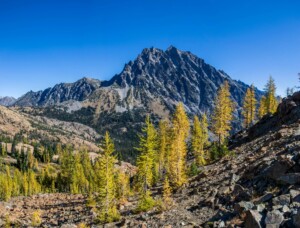
Back in the late 1990’s when I took a Feng Shui class with Master Joseph Yu, he mentioned casually that feng shui is “all about mountains and water.” This was in a workshop for the flying stars, where the permanent hosts in each directional zone of a floor plan are often referred to as Mountain Dragons and Water Dragons. However, he was referring to literal mountains and water.
Viewed from space, our globe appears to be just land masses and water. We don’t easily see the other elements like Wood, Metal or Fire, but we see the continents and the oceans. And it is no wonder that Feng Shui used to be called “Chinese Geomancy.” The practice of geomancy is a separate discipline, but the implication resonates because the origins of Feng Shui deal heavily with tracking, interpreting, and manipulating the Qi forces underground or emanating upward from underground. The whole separate topic of “dowsing” is related in some instances.
Observations also include the inter-relationship between mountains and water, such as streams, ponds, lakes, rivers and oceans. It was the Chinese who discovered and developed a practice called Geo-Botanical Prospecting, where you can tell what minerals are abundant directly underground, based on what kinds of plants grow above.
In Henry B. Lin’s book The Art & Science of Feng Shui, he devotes several chapters to the influence of literal mountains. And just to punctuate from the start, for those who do not live close to actual mountains or even hills, there are ways to replicate mountain energy in your landscape. Virtual mountain remedies are not as substantial as real mountains, but it is still something one can do in the absence of real mountains. This is one of the things I personally love about Feng Shui, as there is an “escape hatch” for many dangers, deficiencies or flaws in the environment.
A lot of Feng Shui books only briefly gloss over the subject of mountains, so I appreciate the depth in which Lin writes. In fact, there is so much in The Art & Science of Feng Shui that I am compelled to feature this part of his book in its own article.
In the chapter on “Key Factors of Feng Shui,” he illustrates how immense life force energies can travel great distances, in and under mountains. When those “dragon veins” and lines of energy are re-directed or interrupted, it can have a definitive impact on the people who live around these mountains. This is one reason why indigenous people often speak out against placing a shopping center on sacred land or why I wince when driving through a tunnel bored through a mountain side.
Feng Shui masters spent a life-time studying the topography, to the point where they could predict the fate of both individuals and whole townships, based on the Feng Shui features of mountains.
Not only is the shape of a mountain significant, but they can be categorized as yin or yang. Mountains can also be categorized within the Five Element Theory system, to the point that a certain mountain shape and proximity could affect a person uniquely based on their birth data.
The travel direction and speed of wind is influenced by the mountain range, its dragon veins and adjoining sources of water. Both mountain and water have the ability to disperse or contain Qi. The soil on the mountain can also be inspected and categorized. Naturally, a mountain with green foliage and healthy animals will cast a more positive influence on the people nearby than a desolate mountain with nothing more than dry earth and rocks.
The mountain becomes a metaphor for the human body, with water and stones compared to the blood and bones of the human body. The soil is the “flesh” and plants are like skin and hair, as noted by Lin.
The mountains and hills also become relevant in relation to the direction and orientation of a structure. He mentioned when it is best for a house to face south literally, but we also know that this takes on a less literal interpretation known as the Four Celestial Animals. These animals (Tortoise, Dragon, Tiger, Phoenix) should align in the back, sides and frontage of the property in order to transmit the ideal, nurturing Qi. The Qi is a type of electromagnetic wave, influenced also by the strongest locations of the world’s electromagnetic waves which correspond with the north and south poles. The entire globe becomes a network of directional Qi, a “world-wide web,” so to speak.
Lin refers to radio astronomers as having discovered that Qi is a kind of microwave radiation and sites an article by Jawaharlal Nehru titled, “Cutting Through the Chatter About Feng Shui, Physics, and the Forces of the Universe,” to underscore that while hardly anyone can see or feel the movement of Qi energy, this does not negate its existence, any more than the fact that animals can hear sounds unavailable to the human ear.
Aside from being able to identify mountains according to their yin or yang qualities (living or dead mountains), or their affinity to one of the Five Elements, Lin also categorizes Mountains and Hills (Dragons) as four major types. We have progressive dragons, lucky dragons, retreating dragons and sick dragons. He describes their shape and look and in relation to a land site. Of course, the image of a dragon has all kinds of mystical and cultural references which go beyond Feng Shui, but the dragon was chosen to best describe the undulating shapes and movement of mountain Qi.

In relation to the land or a structure, we have “table hills” or “worshiping hills.” This describes the hills that are close to the site or further away. Another version of that is the “inner green dragons” versus the “outer green dragons.” We can assume that if a good mountain is further away, that the luck of the people living in its vicinity will convey future luck for them, as opposed to immediate luck. These principles for the mountain analysis can then determine the fate of the people nearby, not just if they will be rich or poor, happy or sad, but even if the mountain Qi will produce saints, warriors, criminals, political leaders, poets, or many other types of professions.
We could create a type of Table Chart to keep track of all this, to include but not limited to:
- Shape of mountain(s), Five Elements
- Mountain(s) descending or ascending posture (as if bowing or taking flight)
- Front or back of the mountain(s)
- Quality of Qi of mountain(s), Yin Yang Features
- Size of mountain(s)
- Proximity of mountain(s)
- Mountain(s) in relation to water sources
- Mountain(s) as Earth Qi influenced by or influencing wind, Heavenly Qi
- Mountain(s) influenced by natural or man-made diversions
Henry B. Lin relates many stories from Chinese folklore about the fortunes of those who harnessed the good Qi of the mountains versus those who sabotaged or ignored the Qi. One story of a military maneuver involved sending a spy to the village who told the peasants they could find gold in the nearby mountain. Disinformation! To the extent that the town’s people started digging and destroying the mountain, the warring enemy was able to walk right in and take over, once the people ruined the Qi of their village’s mountain.
Author: Kartar Diamond
Company: Feng Shui Solutions ®
From the Book Review Blog Series
